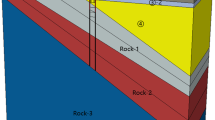Abstract
Lab experiment and mathematical simulation Modular three dimensional finite difference groundwater flowmodel (MODFLOW) were performed in a soil tank to simulate the hydrogeochemical interaction between lake and typical unconfined aquifer. Results show that the velocity decreases exponentially with the transect distance on seepage face. The maximal velocity occurs at the top point of seepage face. The obliquity of seepage face has a great influence on the maximum and distribution of seepage velocity. With the increase of the obliquity of seepage face, the maximal velocity decreases quickly and the velocity distribution becomes much more even. Most of groundwater flow and pollutant flux discharges through a narrow portion near the top of seepage face. The flow and mass concentrated in the narrow portion increase with the decrease of the obliquity of seepage face. These will benefit to design a reasonable and economical scenario to manage lakeshore and to control the pollution of lake water near lakeshore.
Similar content being viewed by others
References
LEE T. M. Effects of nearshore recharge on groundwater interactions with a lake in mantled karst terrain [J]. Water Resources Research, 2000, 36(8): 2167–2182.
KANG W. J., KOLASA K. V. and RIALS M. W. Groundwater inflow and associated transport of phosphorus to a hypereutrophic lake [J]. Environmental Geology, 2005, 47(4): 565–575.
HREFNA Kristmannsdóttir, HALLDÓR Ármannsson. Groundwater in the Lake Myvatn area, northern Iceland: Chemistry, origin and interaction [J]. Aquatic Ecology, 2004, 38(2): 115–128.
CORBETT D. R., CHANTON J. and BURNETT W. et al. Patterns of groundwater discharge into Florida Bay [J]. Limnol Oceanogr, 1999, 44(4): 1045–1055.
KOLAK J. J., MATTY J. M. and LARSON G. J. et al. Ground-water large-lake nteractions in Saginaw Bay, Lake Huron: a geochemical and isotopic approach [J]. Geological Society of America Bull, 1999, 111(2): 177–188.
BELANGER T. V., MIKUTEL D. F. On the use of seepage meters to estimate groundwater nutrient loading to lakes [J]. Water Res. Bull., 1985, 21(2): 265–272.
SUTULA M., DAY J. W. and CABLE J. et al. Hydrological and nutrient budgets of freshwater and estuarine wetlands of Taylor Slough in Southern Everglades, Florida (U.S.A.) [J]. Biogeochemical, 2001, 56(3): 287–310.
TANIGUCHI M., FUKUO Y. Continuous measurements of groundwater seepage using an automatic seepage meter [J]. Ground Water, 1993, 31(4): 675–679.
CHEN Jing, ZHOU Zhi-fang and JIA Suo-bao. Analytical solution of groundwater fluctuations in estuarine aquifer [J]. Journal of Hydrodynamics, Ser. B, 2005, 17(5): 641–646.
SHAW R. D., SHAW J. F. H. and FRICKER H. et al. An integrated approach to quantify groundwater transport of phosphorus to Narrow Lake, Alberta [J]. Limnol and Oceanography, 1990, 35(4): 870–886.
ROBERT J. S., DOUGLAS A. W. and TODD A. T. et al. Interactions between ground water and wetlands, southern shore of Lake Michigan, USA [J]. Journal of Hydrology, 1993, 141(1-4): 127–155.
TANIGUCHI M. Evaluation of the groundwater capture zone for modeling of nutrient discharge [J]. Hydrological Processes, 2001, 15(10): 1939–1949.
FUKUO Y., KAIHOTSU I. A theoretical analysis of seepage flow of confined groundwater into the lake bottom with a gentle slope [J]. Water Resources Research, 1988, 24(11): 1949–1953.
MCBRIDE M.S., PFANNKUCH H. O. The distribution of seepage within lakebeds [J]. Journal Research U.S. Geological Survey, 1975, 3(5): 505–512.
JOHN P.H., LOCK M. A. The spatial distribution of groundwater discharge into the littoral zone of a New Zealand Lake [J]. Journal of Hydrology, 1977, 33: 391–395.
VOLKER R. E., ZHANG Q. and LOCKINGTON D. A. Numerical modelling of contaminant transport in coastal aquifers [J]. Mathematics and Computers in Simulation, 2002, 59(1–3): 35–44.
LI Yong, WANG Chao. Theoretical estimation of groundwater discharge and associated nutrient loading to a lake with gentle slope bottom [J]. Journal of Hydrodynamics, Ser. B, 2007, 19(1): 30–35.
HUANG Yi-ping. Water environment and pollution control of Taihu Lake [M]. Beijing: China Science Press, 2001 (in Chinese).
MCDONALD M. G., HARBAUGH A. W. A modular three-dimensional finite difference ground water flow model-U.S. geological survey techniques of water-resources investigations (Book 6) [M]. Washington: United States Government Printing Office, 1988.
WINTER T. C. Numerical simulation of steady-state three dimensional groundwater flow near lakes [J]. Water Resources Research, 1978, 14(2): 245–254.
YIN Hai-long, XU Zu-xin and LI Huai-zheng et al. Numerical modeling of wastewater transport and degradation in soil aquifer [J]. Journal of Hydrodynamics, Ser. B, 2006, 18(5): 597–605.
Author information
Authors and Affiliations
Corresponding author
Additional information
Project supported by the National Natural Science Foundation of China (Grant No. 40601050) and the National Basic Research Program of China (973 Program, Grant No. 2002CB412303) and the Jiangsu Province Qinglan Project (2006).
Biography: LI Yong (1974-), Male, Ph. D., Lecturer
Rights and permissions
About this article
Cite this article
Li, Y., Wang, C., Yang, Lz. et al. Influence of Seepage Face Obliquity on Discharge of Groundwater and its Pollutant Into Lake from a Typical Unconfined Aquifer. J Hydrodyn 19, 756–761 (2007). https://doi.org/10.1016/S1001-6058(08)60014-1
Received:
Revised:
Published:
Issue Date:
DOI: https://doi.org/10.1016/S1001-6058(08)60014-1




